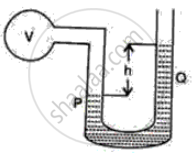Advertisements
Advertisements
प्रश्न
The atmospheric pressure at a place is 650 mm of Hg. Calculate this pressure in Pascals (Pa).
उत्तर
Height of mercury column = h = 650 mm
h = 65 cm = 0.65 m
Density of mercury = ρ= 13600 kg/m3
Acceleration due to gravity = g = 10 ms−2
Pressure (P) = 650 mm of Hg = hρg
= 0.65 × 13600 × 10
= 88400 Pa
APPEARS IN
संबंधित प्रश्न
Define one pascal (Pa), the S.I. unit of pressure.
Explain the principle of a hydraulic machine. Name two devices which work on this principle.
The area of cross-sections of the pump plunger and press plunger of a hydraulic press is 0.02 m2 and 8 m2 respectively. If the hydraulic press overcomes a load of 800 kgf, calculate the force acting on the pump plunger.
Select the correct option.
Pressure applied in liquids is transmitted with undiminished force
How does the liquid pressure on a diver change according to the following condition:
When the driver moves to the greater depth?
The following figure shows a manometer containing a liquid of density p. The limb P of the manometer is connected to a vessel V and the limb Q is open to atmosphere. The difference in the levels of liquid in the two limbs of the manometer is h as shown in the diagram. The atmospheric pressure is P0.
(i) What is the pressure on the liquid surface in the limb Q?
(ii) What is the pressure on the liquid surface in the limb P?

The density of iron is 7800 kg m-3. What do you mean by this statement? What is density of water at 40C?
Pascal’s law is used in
